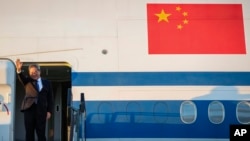ນາຍົກລັດຖະມົນຕີຈີນ ທ່ານ ລີ ຈຽງ ໄດ້ສິ້ນສຸດການຢ້ຽມຢາມ 3 ປະເທດຂອງພາກພື້ນເອເຊຍປາຊີຟິກ, ເພື່ອຂະຫຍາຍການພົວພັນດ້ານການຄ້າ ແລະສ້າງສາຍພົວພັນຄືນໃໝ່. ແຕ່ການເດີນທາງດັ່ງກ່າວ ຍັງໄດ້ພົບເຫັນບັນຫາທາງການທູດທີ່ຍັງມີຄວາມຫຍຸ້ງຍາກຢູ່ບາງຢ່າງ.
ຜ່ານການຢ້ຽມຢາມຄັ້ງນີ້, ທ່ານ ລີ ເຊິ່ງເປັນເຈົ້າໜ້າທີ່ທີ່ມີອຳນາດອັນດັບສອງຂອງຈີນ, ໄດ້ກາຍເປັນນາຍົກລັດຖະມົນຕີຄົນທຳອິດ ທີ່ໄປຢ້ຽມຢາມນິວຊີແລນ ແລະອອສເຕຣເລຍ ນັບຕັ້ງແຕ່ປີ 2017.
ທ່ານໄດ້ສິ້ນສຸດການເດີນທາງຢ້ຽມຢາມຂອງທ່ານ ຢູ່ປະເທດມາເລເຊຍ, ເຊິ່ງຖືເປັນຂີດໝາຍຄວາມສະຫງົບອັນຍາວນານເກືອບທົດສະວັດນັບຕັ້ງແຕ່ຜູ້ດຳລົງ ຕໍາແໜ່ງຄົນກ່ອນຂອງທ່ານຄື ທ່ານ ລີ ເກີ້ຈຽງ (Li Keqiang) ໄດ້ໄປຢ້ຽມຢາມປະເທດເອເຊຍຕາເວັນອອກສ່ຽງໃຕ້ດັ່ງກ່າວໃນປີ 2015.
ການຢ້ຽມຢາມຂອງທ່ານ ລີ (Li) ໄດ້ປະກາດຜົນໄດ້ຮັບບາງຢ່າງ, ລວມທັງການປະກາດຂໍ້ຕົກລົງການຄ້າໃໝ່ ກັບນິວຊີແລນ ແລະ ມາເລເຊຍ.
ແຕ່ເຫດການອັນແປກປະຫລາດຢ່າງນຶ່ງ ຢູ່ທີ່ນະຄອນຫຼວງ ແຄນເບີຣາ ເຊິ່ງກ່ຽວຂ້ອງກັບເຈົ້າໜ້າທີ່ຈີນ ແລະນັກຂ່າວທ້ອງຖິ່ນຄົນນຶ່ງ ທີ່ເຄີຍຖືກຂັງຄຸກໃນເມື່ອກ່ອນນັ້ນ ໄດ້ຖືກອະທິບາຍ ໂດຍນາຍົກລັດຖະມົນຕີອອສເຕຣເລຍ ທ່ານ ແອນໂທນີ ອາລບານີສ (Anthony Albanese) ວ່າ "ບໍ່ເໝາະສົມຢ່າງຍິ່ງ".
ການຢ້ຽມຢາມຂອງທ່ານ ລີ ໄດ້ເລີ່ມຕົ້ນໃນລັກສະນະທີ່ມິດງຽບຫຼາຍຂຶ້ນ, ໂດຍມີການພົບປະກັບນາຍົກລັດຖະນາຍົກຂອງ ນິວຊີແລນ ທ່ານ ຄຣິສໂຕເຟີ ລູຊອນ (Christopher Luxon) ສໍາລັບການເຈລະຈາ ຢູ່ທີ່ນະຄອນຫຼວງ ວິລລິງຕັນ (Wellington).
ທັງສອງຝ່າຍ ໄດ້ປະກາດຂໍ້ຕົກລົງໃໝ່ກ່ຽວກັບການຄ້າ ແລະການປ່ຽນແປງຂອງດິນຟ້າອາກາດ, ໂດຍທ່ານ ລີ ກ່າວວ່າ 2 ປະເທດເປັນ “ເພື່ອນມິດທີ່ດີ.”
ອ່ານຂ່າວເປັນພາສາອັງກິດຂ້າງລຸ່ມນີ້:
Chinese Premier Li Qiang has wrapped up a three-country tour of the Asia-Pacific region, boosting trade ties and rebuilding relations. But the trip also saw a reemergence of some thorny diplomatic issues.
Through this visit Li, the second most powerful official in China, became the first premier to visit New Zealand and Australia since 2017.
He wrapped up his trip with a stop in Malaysia, marking an almost decade-long lull since his predecessor Li Keqiang visited the Southeast Asian nation in 2015.
Li’s tour heralded some results, including the announcement of new trade deals with New Zealand and Malaysia.
But a bizarre incident in Canberra involving Chinese officials and a formerly imprisoned local journalist was described as “entirely inappropriate” by Australian Prime Minister Anthony Albanese.
Li’s tour began in a more muted manner, with the premier meeting New Zealand Prime Minister Christopher Luxon for talks in Wellington.
The pair announced new agreements on trade and climate change, with Li describing the two countries as “good friends.”
Luxon, though, said the split was “probably 50-50” in time spent discussing differences between the two countries compared to their common interests.
New Zealand’s leader had a “challenging course” to navigate, according to Kathryn Paik, a senior fellow with the Australia Chair at the Center for Strategic and International Studies, balancing economic priorities with concerns over China’s increasing engagement in the Pacific.
“This balancing will become more difficult, as New Zealand continues to become more aware of the detrimental effects of Chinese actions abroad,” Paik told VOA.
The Chinese premier also raised concerns about New Zealand’s potential participation in the AUKUS security alliance — a trilateral pact between Australia, the United Kingdom and the United States — that is seen as a counter to Beijing's influence in the Indo-Pacific region.
From New Zealand, Li touched down in Australia for a meeting closely watched after relations between the two took a nosedive during the pandemic.
Australia’s former Prime Minister Scott Morrison was a vocal critic of China on a number of issues, from human rights to calling for an international inquiry into the origins of the COVID-19 pandemic.
Beijing hit back, slapping tariffs and restrictions on a variety of Australian goods and commodities.
The Albanese administration has worked to rebuild the relationship with the key trading partner and this visit was evidence of how far things have come.
Canberra and Beijing “are back to the normal pattern of relations now,” said former Australian Ambassador to China Geoff Raby.
“Sure, there are big differences and issues that we disagree on. But that's the same in all relationships,” Raby told VOA.
Beijing’s so-called “panda diplomacy” was on full display during the visit, with Li announcing China would send Adelaide Zoo two new giant pandas, replacing Wang Wang and Fu Ni who are returning to their homeland.
The premier also offered 15-day, visa-free entry for Australian visitors to China, something also promised to New Zealand citizens during his visit there.
Albanese said he and Li also discussed improving military dialogue between the countries, after a recent incident when a Chinese jet dropped flares in the pathway of an Australian defense helicopter over the Yellow Sea.
But while Albanese may have said the trip “renewed and revitalized” relations with China, all local media outlets could talk about was what happened with Cheng Lei — an Australian journalist who recently returned home from three years detention in China.
Lei was reporting on a press conference at Canberra’s Parliament House when Chinese officials appeared to block cameras from filming her.
“It was a complete stuff-up by the Chinese side, stupid, completely stupid. They are their own worst enemies,” said former ambassador Raby.
“It really did deflect attention within Australia from the positive aspects of the visit. It was such a stupid thing,” Raby told VOA.
The final leg of Li’s tour was in Malaysia, with the Chinese premier marking fifty years of diplomatic relations with his hosts.
Li met with Prime Minister Anwar Ibrahim and the pair witnessed the signing of a slew of new deals, such as a five-year agreement to boost economic and trade cooperation.
The pair also jointly pushed a lever to break ground at the construction of a new railway station that will form a key part of China’s prized Belt and Road Infrastructure project.
In addition, China promised to begin importing fresh durians from Malaysia. The Southeast Asian nation is one of the world’s biggest producers of the notoriously smelly fruit.
Malaysia, like much of the Indo-Pacific, is walking a tightrope in balancing relations with its biggest trading partner China and the United States. Kuala Lumpur recently received large investments from major U.S. companies including Microsoft and Google.
It’s an approach of “strategic ambiguity,” according to James Chin, professor of Asian studies at the University of Tasmania. “They don’t show their hand too openly.”










ຟໍຣັມສະແດງຄວາມຄິດເຫັນ